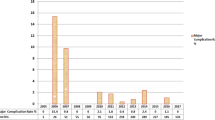Abstract
Background
Laparoscopic sleeve gastrectomy (LSG) is one of the most frequently performed procedures in obesity surgery. The benefits of minimally invasive surgery include rapid recovery. We evaluated the clinical outcomes of different resection margin lengths from the pylorus in LSG.
Methods
This retrospective study included 152 patients who underwent LSG from January 2011 to October 2014. The antrum was resected 2 cm from the pylorus in 84 patients (group A) and 6 cm from the pylorus in 68 patients (group B). The patients’ demographics, staple line distance, complications, sex, age, body mass index loss, length of hospital stay, and comorbidities were retrospectively reviewed.
Results
The patients comprised 104 women (68.4 %) and 48 men (32.6 %) with a mean age of 41.2 years (range, 28–53 years). The percent total and excess weight loss were statistically significant in both groups at 6 and 12 months postoperatively. Weight loss was significantly greater in group A than that in B at 6 and 12 months, but the difference at 24 months was not statistically significant. The results of pH monitoring showed significantly lower scores in group A than those in B at 6 and 12 months, but no difference at 24 months.
Conclusion
LSG is an effective procedure with good short-term outcomes. Both procedures described herein are equally effective with respect to the patient’s return to daily activities. Increasing the distance from the resection line to the pylorus is associated with better weight loss but slightly increased symptoms of gastroesophageal reflux disease without a significant difference in complications.
Similar content being viewed by others

References
Roa PE, Kaidar-Person O, Pinto D, et al. Laparoscopic sleeve gastrectomy as treatment for morbid obesity: technique and short-term outcome. Obes Surg 2006 Oct. 16(10):1323–6
Jimenez A, Casamitjana R, Flores L, et al. Long-term effects of sleeve gastrectomy and Roux-en-Y gastric bypass surgery on type 2 diabetes mellitus in morbidly obese subjects. AnnSurg. 2012;256(6):1023–9.
Givon-Madhala O, Spector R, Wasserberg N, et al. Technical aspects of laparoscopic sleeve gastrectomy in 25 morbidly obese patients. Obes Surg. 2007;17(6):722–7.
Mognol P, Chosidow D, Marmuse JP. Laparoscopic sleeve gastrectomy as an initial bariatric operation for high-risk patients: initial results in 10 patients. Obes Surg. 2005;15(7):1030–3.
Baltasar A, Serra C, Pérez N, et al. Laparoscopic sleeve gastrectomy: a multi-purpose bariatric operation. Obes Surg. 2005;15(8):1124–8.
Rosenthal RJ, International Sleeve Gastrectomy Expert Panel, Diaz AA, et al. International Sleeve Gastrectomy Expert Panel Consensus Statement: best practice guidelines based on experience of >12, 000 cases. Surg Obes RelatDis. 2012;8(1):8–19.
Himpens J, Dobbeleir J, Peeters G. Long-term results of laparoscopic sleeve gastrectomy for obesity. Ann Surg. 2010;252(2):319–24.
Chiu S, Birch DW, Shi X, et al. Effect of sleeve gastrectomy on gastroesophageal reflux disease: a systematic review. Surg Obes RelatDis. 2011;7:51015.
Frezza EE. Laparoscopic vertical sleeve gastrectomy for morbid obesity. The future procedure of choice? Surg Today. 2007;37(4):275–81.
Lyon A, Gibson SC, De-loyde K, et al. Gastroesophageal reflux in laparoscopic sleeve gastrectomy : hiatal findings and their management influence outcome. Surg Obes Relat Dis. 2015;11(3):530–7.
Weiner RA, Weiner S, Pomhoff I, et al. Laparoscopic sleeve gastrectomy—influence of sleeve size and resected gastric volume. Obes Surg. 2007;17:1297–305.
Parikh M, Gagner M, Heacock L, et al. Laparoscopic sleeve gastrectomy: does bougie size affect mean %EWL? Short-term outcomes. Surg Obes Relat Dis. 2008;4:528–33.
Dindo D, Demartines N, Clavien PA. Classification of surgical complications: a new proposal with evaluation in a cohort of 6336 patients and results of a survey. Ann Surg. 2004;240(2):205–13.
Zerbib F, Varannes SB, Roman S, et al. Normal values and day-to-day variability of 24-h ambulatory oesophageal impedance-pH monitoring in a Belgian-French cohort of healthy subjects. Aliment Pharmacol Ther. 2005;22(10):1011–21. doi:10.1111/j.1365-2036.2005.2677.
Higginson I, Carr A. Using quality of life measures in the clinical setting. BMJ. 2008;322:1297–300.
Brunault P, Jacobi D, Léger J, et al. Observations regarding ‘quality of life’ and ‘comfort with food’ after bariatric surgery: comparison between laparoscopic adjustable gastric banding and sleeve gastrectomy. Obes Surg. 2011;21(8):1225–31.
Abdallah E, El Nakeeb A, Yousef T, et al. Impact of extent of antral resection on surgical outcomes of sleeve gastrectomy for morbid obesity. Obes Surg. 2014;24:1587–94.
A ElGeidie, M ElHemaly, E Hamdy, et al. The effect of residual gastric antrum size on the outcome of laparoscopic sleeve gastrectomy: a prospective randomized trial. Surgery for obesity and related diseases (2015).
M. Gagner. Is sleeve gastrectomy always an absolute contraindication in patients with Barrett’s?. Obesity Surgery, november, 2015
Rebecchi F, Allaix ME, Giaccone C, et al. Gastroesophageal reflux disease and laparoscopic sleeve gastrectomy: a physiopathologic evaluation. Ann Surg. 2014;n260:909–14.
Nıan Y, Feng C, Jıng F, et al. Reflux characteristics of 113 GERD patients with abnormal 24-h multichannel intraluminal impedance-pH tests. zhejiang univ-sci b (biomed & biotechnol). 2015;16(9):805–10.
Farre R, van Malenstein H, de Vos R, et al. Short exposure of oesophageal mucosa to bile acid, both in acidic and weakly acidic conditions, can impair mucosal integrity and provoke dilated intercellular spaces. Gut. 2008;57(10):1366–74.
Cottam D, Qureshi FG, Mattar SG, et al. Laparoscopic sleeve gastrectomy as an initial weight-loss procedure for high-risk patients with morbid obesity. Surg Endosc. 2006;20(6):859–63.
Soricelli E, Iossa A, Casella G, et al. Sleeve gastrectomy and crural repair in obese patients with gastroesophageal reflux disease and/or hiatal hernia. Surg Obes Relat Dis. 2013;9(3):356–61.
Author information
Authors and Affiliations
Corresponding author
Ethics declarations
Ethics Approval
All procedures performed in studies involving human participants were in accordance with the ethical standards of the institutional and/or national research committee and with the 1964 Helsinki declaration and its later amendments or comparable ethical standards.
Informed Consent
For this type of study, formal consent was not required; this was a retrospective study.
Conflict of Interest
The authors declare that they have no competing interests.
Additional information
University of Selcuk at Konya is where the work was performed.
Rights and permissions
About this article
Cite this article
Yormaz, S., Yılmaz, H., Ece, I. et al. Midterm Clinical Outcomes of Antrum Resection Margin at Laparoscopic Sleeve Gastrectomy for Morbid Obesity. OBES SURG 27, 910–916 (2017). https://doi.org/10.1007/s11695-016-2384-9
Published:
Issue Date:
DOI: https://doi.org/10.1007/s11695-016-2384-9



